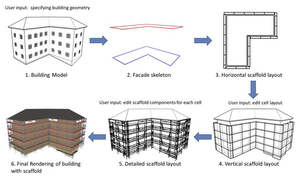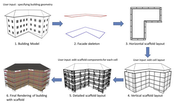Information
- Publication Type: Journal Paper (without talk)
- Workgroup(s)/Project(s):
- Date: June 2013
- ISSN: 0097-8493
- Journal: Computer & Graphics
- Number: 4
- Volume: 37
- Pages: 256 – 268
Abstract
To manually specify an optimal scaffold assembly for a given building geometry is a time consuming task. Our goal is to automate the process of selecting and placing scaffold components in order to design an optimal scaffold assembly for a specific building. The resulting assembly must be possible to construct in practice, should be practical to use for the workers, must satisfy governmental rules and regulations and should ideally result in minimum accumulated component cost. We propose a novel procedural modeling pipeline based on an input house model. First we extract vital coordinates from the house model that define the 3D scaffold placement. These coordinates are the basis for defining the positioning of scaffold cells. In the next step we populate the cells with actual scaffold components geometry. The resulting model is visualized to assist the assembly process. Additionally it is decomposed into elementary building blocks to produce assembly component lists to estimate the scaffold cost estimates, compute the weight for transportation and packing of components from a warehouse. The result from the automated process is compared to scaffold design produced manually by a professional scaffold designer.Additional Files and Images
Weblinks
BibTeX
@article{Viola_Ivan_2013_RMA,
title = "Rule-based method for automatic scaffold assembly from 3D
building models",
author = "Tyge Løvset and Dag Magne Ulvang and Tor Christian
Bekkvik and K{\aa}re Villanger and Ivan Viola",
year = "2013",
abstract = "To manually specify an optimal scaffold assembly for a given
building geometry is a time consuming task. Our goal is to
automate the process of selecting and placing scaffold
components in order to design an optimal scaffold assembly
for a specific building. The resulting assembly must be
possible to construct in practice, should be practical to
use for the workers, must satisfy governmental rules and
regulations and should ideally result in minimum accumulated
component cost. We propose a novel procedural modeling
pipeline based on an input house model. First we extract
vital coordinates from the house model that define the 3D
scaffold placement. These coordinates are the basis for
defining the positioning of scaffold cells. In the next step
we populate the cells with actual scaffold components
geometry. The resulting model is visualized to assist the
assembly process. Additionally it is decomposed into
elementary building blocks to produce assembly component
lists to estimate the scaffold cost estimates, compute the
weight for transportation and packing of components from a
warehouse. The result from the automated process is compared
to scaffold design produced manually by a professional
scaffold designer.",
month = jun,
issn = "0097-8493",
journal = "Computer & Graphics",
number = "4",
volume = "37",
pages = "256--268",
URL = "https://www.cg.tuwien.ac.at/research/publications/2013/Viola_Ivan_2013_RMA/",
}


